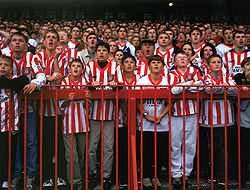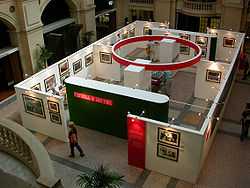The Homes of Football

The Homes of Football (1989–present) is an ongoing collection of work of photographer Stuart Roy Clarke.[1] Pictures from the collection have been toured as an art exhibition, displayed as a permanent museum, released in book form, and used for adverts and for campaigns on behalf of football's governance, particularly by The Football Trust (the forerunner to The Football Foundation)[2]
The collection has had the singular support of the professional Footballers Association all along[3]
Comprising over 100,000 images, The Homes of Football is one of the largest collections of football photography in the world.
Origins
Stuart Clarke began The Homes of Football in the wake of the Hillsborough Disaster and the resulting Taylor Report. Clarke's stated aim was "to show the beauty of a nation, even if a lot of what its people say and do is not beautiful. And to show the beauty of football that is ever more a World game. And to keep on showing it."[4] The earliest photograph in the collection is of four boys at Kilbowie Park, home of Clydebank, in 1989 - a club and ground that has since disappeared. During the 1990s, Clarke made thousands of trips to football matches, photographing the crowd and the grounds themselves. This focus on the ordinary football supporter, rather than the more 'glamorous' side of the game, led to an article in The Times claiming that "if Nick Hornby gave the fan a voice in the nineties, Clarke has given the fan a face.” Clarke was also the only official photographer for The Football Trust from 1991 and its successor The Football Foundation until 2005.[5]
The collection
Though a lifelong Watford FC supporter[6] Clarke's work covers over 400 Football Clubs in dozens of countries and above all in the UK. The clubs range from humble park football through the English Pyramid and up through all UK domestic Leagues, and beyond club football to the teams representing their countries on the international stages.
Featured tournaments
Major football tournaments featured in The Homes of Football include : the 1990, 1994, 1998, 2002 and 2006 FIFA World Cups, the UEFA European Championships in 1996, 2000, 2004 and 2008 as well as all the Premier League seasons, as well as The Football League seasons since 1990. About a fifth of the collection involves Scottish league and cup competitions.
Grass roots
Stuart Clarke's family were involved in the organisation of youth and grass roots football and Clarke attended hundreds of matches at this level as a player and observer in the years before he became a photographer and began The Homes of Football.
Historical aspect
Above all The Homes of Football is committed to the legacy of the professional game. A number of changes to the game at senior level can be seen through the Clarke collection, including : the gradual replacement of terraced stands by seating areas altering the match-day experience, plus a return to perceived family values after the 1970s and 1980s decades of decay and hooliganism. Christian Dymond of The Independent notes that "through Clarke's lens, much about football still seems quaint. There is a shot, for instance, of the coracle at Shrewsbury Town that waits, dutifully, for the ball to plop into the River Severn before being launched."[5]
The technical photographic artistry
The Homes of Football is composed of photographs taken entirely on medium format film, without cropping or undue retouching and no photoshop, using a Bronica camera without any change of (standard) lens nor use of light meter. The transparencies (positives) are then scanned to produce digital files for archiving and print production.
The exhibitions

As possibly the longest unbroken touring art exhibition in British history, 1991–2005, The Homes of Football was the subject of 89 major exhibitions, seen by over 3 million people. The first exhibition was staged at the Burnley Towneley Hall in 1991. The 1994-95 offering on home turf, at Carlisle's Tullie House Museum, coined the phrase "Football's Coming Home... (to Tullie House)" made popular in the "Three Lions" song for Euro'96 attributed to Frank Skinner and David Baddiel. Christian Dymond writing in The Independent declared "Lowry's paintings have come to Tullie House in Carlisle and so have Sebastiao Salgado's photographs and John Keane's paintings from the Gulf War...Stuart Clarke's 250 photographs have eclipsed them all."[7]
The exhibition tour was devised by Clarke to tour the provinces - and not just the major cities - and would where possible contain material related to the local clubs. This included Clarke's pictures of those clubs plus memorabilia and groundsmen's effects. Each show was hired by and held at a public municipal museum or art gallery and was free admission to the public. The tour was supported financially throughout by The Professional Footballers Association and every show was sponsored. Moreover at each exhibition 'opening' a distinguished person did the unveiling honours; the role call includes: Sam Allardyce, Craig Brown, Phil Brown, Roy Evans, Alan Green, George Hardwick, Graeme Le Saux, Craig Levein, Wilf Mannion, Alex McLeish, John Motson, Martin O'Neill, Niall Quinn, John Richards, Sir Bobby Robson, Gordon Smith, Graham Taylor, Clare Tomlinson and Tony Waddington.
Permanent home
When Clarke began the tour "there were no museums of a national standing - indeed only Manchester United had its own museum."[8] Intending a home for his growing collection made up of above all English & Scottish football, Clarke got together with Michael Knighton, then Chairman of Carlisle United, to propose a Museum of British Football at the Brunton Park Ground. Tom Finney visiting the touring show in Carlisle (1994) returned to Preston to report to the then Chairman of Preston North End football club, of the Carlisle (United) plan, and within months a rush to house a national football Museum was on. Eventually the Carlisle plan was squeezed out by a successful Preston initiative in England (2001) and by a National Football Museum for Scotland at Hampden Park (2001) run by the Scottish FA. Clarke looked to do something permanent himself and this was to become The Homes of Football At Ambleside opened on December 1, 1997.
Ambleside

For more than 13 years The Homes of Football occupied an historic Victorian building once home to the Mason brothers' art gallery in Ambleside in the heart of The English Lake District. Pioneers of sporting photography, the Masons specialised in ice-skating and Cumberland wrestling. In 1955 The Art Gallery became one of the first places to display the Illustrations of Alfred Wainwright. During The Homes of football residency around 2 million visitors crossed its threshold[9] and the gallery was consistently in the top 10 Lakeland attractions in order of visitation. In 2005 in an interview with Helen Skelton of the BBC, Clarke suggested that The Homes of Football had to keep evolving to stay relevant and that bigger stages still were ahead.[10]
The new National Football Museum
Talks began in 2007 to take the bulk of the Homes of Football collection to the National Football Museum in Preston. This plan was superseded by the entire Preston operation being uprooted and transferred to Manchester, taking with it the Clarke collection. The Preston and Ambleside bases are now both closed in preparation for the new National Football Museum[11] opening in Cathedral Gardens in central Manchester in 2012, in the building formerly known as Urbis.
Critical response
Kevin Roberts, Worldwide CEO of Saatchi&Saatchi, described the Ambleside gallery as "an amazing experience"[12] in a 2009 article about Clarke's work on his blog aimed at the creative and advertising world. The newspapers over the many years had nothing but praise for the work. Jonathan Northcroft writing for Scotland on Sunday in 1996 on visiting the touring show of The Homes of Football at Edinburgh City Art Centre described it thus : “See it. Artists and photographers have captured the beat of the action, the sweep of the stadia, the whorl of football crowds in the past but only in separation or in pinpricks. Never before have these been brought so together, so consistently as Clarke’s. His eloquent lens tells, always compassionately, about an experience so regularly shared, so seldom vocalised by all of us who watch, play or simply live in the vicinity of football. His collection of frosted moments, which fill the gallery lovingly and with daring are those which are customarily off camera, or buried deep within football pictures”[13]
In 1998 reviewing the show at the Bristol Museum & Art Gallery Phil Johnston of The Independent writes "These are like pictures from another world. In Blood Red Road End, Barnsley, the painted brick wall topped by shards of glass is like a Rothko; its companion piece Yellow Brick Road is as luminous as a Matisse from Morocco. The colour prints shine as if lit from within, and a burger stall outside Highbury looks as if it’s part of an avant-garde stage-set. In High Noon in North London, Arsenal play out their game against a mauve sky so unreal that you half expect a celestial whistle to emerge from the heavens and call time. There are fans : fattie Toon-army-ites bearing their beer-guts proudly; moustachioed scousers pinned back in their queue by a police-horse’s arse at Everton; a whole stand of punters all looking to their right as if lit by Caravaggio.”[4]
The football establishment was not blind to the artistic achievement of The Homes of Football.
Bryan Robson the then manager of Middlesbrough writes in 1996 “Stuart Clarke has brought to life the international game of football with a series of outstanding, innovative and often witty photographs.”[14] Mike Foster, General Secretary of The FA Premier League added in 1998 “The exhibition really is paradise for any lover of football. The feelings I had were not dissimilar to walking into an empty stadium; soaking up the atmosphere and letting your imagination wander – you really do lose yourself in the surroundings” ... and in 2010 on the release of an anthology of Clarke's Homes of Football work adds "I never tire of looking at the photographs. They are captivating and evocative of a football lovers’ halcyon days."
The Sunday Times in 2005 picks up on the unusual achievement of The Homes of Football in appealing to the usually separate audiences of football and art : “Few people pop into the National gallery before a Saturday football fixture or reset their videos from Match of The Day so they can catch the Late Review. It seems that the worlds of art and football are mutually alien, divided along class lines, each mistrusting and resenting the other and each promoting knowledge and enjoyment of their interest to the exclusion of the casual supporter. It is a brave man who attempts to united these two cultures…”[4]
Works featuring The Homes of Football
Books
- The Homes of Football (1996) by Stuart Clarke
- Passion of A Nation (1999) by Stuart Clarke
- More Than A Game (2001) by Stuart Clarke
- Football In Our Time (2003) by Stuart Clarke
- England The Light (2004) by Stuart Clarke
- Football Nation (2009) by Andrew Ward and John Williams
- Cradle Of The Game (2010) by Stuart Clarke
Television
- A Common Passion (1996) ITV written and presented by Stuart Clarke
- Splendid Isolation (2000) ITV written and presented by Stuart Clarke
References
- ↑ http://stuartroyclarke.co.uk/
- ↑ http://www.footballfoundation.org.uk/
- ↑ http://www.givemefootball.com/
- ↑ 4.0 4.1 4.2 http://www.homesoffootball.co.uk/about/
- ↑ 5.0 5.1 Dymond, Christian (16 December 1994). "The ever-changing face of football in the Nineties". The Independent (London). Retrieved 25 May 2010.
- ↑ Football Nation (2009) by Andrew Ward and John Williams
- ↑ http://www.nationalfootballmuseum.com/pages/news/latest/savedforthenationcarlisle.html
- ↑ From "A Common Passion" tv documentary written and presented by Stuart Clarke, ITV 1996
- ↑ http://www.lakedistrict.gov.uk/index/learning/facts_and_figures/factstourism.htm
- ↑ http://www.bbc.co.uk/cumbria/content/articles/2005/04/02/homes_of_football_april05_feature.shtml
- ↑ http://www.nationalfootballmuseum.com/
- ↑ http://krconnect.blogspot.com/2009/05/homes-of-football.html
- ↑ http://www.fsf.org.uk/uploaded/publications/pdfs/tfs23_web.pdf
- ↑ http://www.wemakemedia.co.uk/blog/2010/homes-football-re-launch/